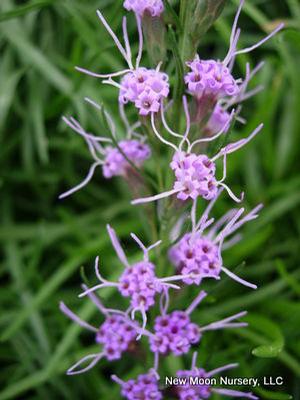Printed at http://www.newmoonnursery.com/index.cfm/

Appalachian blazing star is a drought tolerant perennial, good choice for the garden, restoration, meadow plantings.
Liatris microcephala
Appalachian blazing star
Native to North America
FIRST IMPRESSIONS: Liatris microcephala is a showy drought tolerant perennial that forms soft mounded tufts of grass-like foliage. The compact plants have multiple stems clothed in narrow leaves. In late summer multitudes of small rosy purple flower heads are displayed above the leaves on upright stalks. This is a tough drought tolerant wildflower that prospers in sunny sites with lean dry soils.
HABITAT & HARDINESS: Liatris microcephala occurs in the southeastern United States from North Carolina to Georgia and west to Kentucky and Alabama mostly in the Southern Appalachian Mountains.
Plants are indigenous to dry sandy prairies, rock outcrops (especially those composed of acidic rocks like sandstone, granite or gneiss), open woodlands, rocky slopes, sunny glades, sandy stream banks and clearings in pine-oak or oak barrens.
Plants are hardy from USDA Zones 4-8.
PLANT DESCRIPTION: Liatris microcephala is a diminutive gayfeather that produces multiple upright stems from rounded woody underground corms.
Leaves are linear to lanceolate with the largest basal leaves being about 1/4” wide and up to 6” long. The glabrous blades become progressively smaller as the stalk rises. They are deep green and are arranged close together on the stem.
In late summer flower stalks erupt into spikey inflorescences composed of many delicate orchid colored heads. Each head consists of a small bundle of 4-6 disc florets.
Blooming begins at the top of the flower stalk and progresses downward. The flower display continues from late summer until autumn for 3-4 weeks.
After flowering, small tufts of fluffy golden brown achenes drift on the wind to their new homes.
This wee gayfeather averages 2’ tall with 1’ spread.
CULTURAL & MAINTENANCE NEEDS: Liatris microcephala is a tough cookie that flourishes in xeric-types sites with full sun and lean dry soils.
Plants tolerate drought and adapt to loamy, clay, sandy or rocky soils. Slightly acid pH is preferred.
This species will grow in most average well drained garden soils but will flop if soil is too rich or moist. Plants require an uncrowded open planting space with plenty of sun and good drainage especially in winter.
This is a pest resistant species with blossoms that attract butterflies and hummingbirds.
LANDSCAPE USES: This gayfeather is a good Accent or Edging plant for a Wildlife Garden or Rock Garden. It is an appropriate Container Plant, Cut Flower or Butterfly Nectar Plant. Liatris microcephala has Showy Blooms and could be use in a Grouping or Mass Planting for Cottage Gardens, Water-wise Landscapes, Low Maintenance Plantings and Perennial Borders.
COMPANION & UNDERSTUDY PLANTS: Try pairing Liatris microcephala with Baptisia tinctoria, Coreopsis major, Chyrsopsis mariana, Ruellia humilis, Solidago nemoralis or Schizachryrium scoparium.
Liatris squarrosa could be a substituted due to similar flower color, bloom time and habitat needs. Growth habit, texture and size are quite different, however.
TRIVIA: Liatris microcephala has been recommended as a suitable candidate for Green Roofs due to its ability to adapt to harsh dry sunny conditions.
This species was formerly recognized as Lacinaria microcephala. The specific epithet means “small headed”. Also known by the common names Dwarf Blazing Star and Small Headed Gayfeather.
Height:
2 ftSpread:
1 ftSpacing:
18-24 inUSDA Hardiness Zone:
4-8Bloom Color:
Purple, RoseLiatris microcephala Characteristics
Attracts Wildlife
- Butterflies
- Songbirds
- Pollinators
- Hummingbirds
Attributes
- Rock Garden
- Drought Tolerant
- Cut Flower
Exposure
- Full Sun to Partial Shade
Deer Resistant
- Deer Resistant
Flowering Months
- September
- August
Foliage Color
- Green
Soil Moisture Preference
- Moist to Dry
Interesting Notes:
For more information on this plant, visit the USDA PLANTS Database. http://plants.usda.gov/java/profile?symbol=LIMI7
